In Silicon Valley, the California tech hub that hosts some of the nation’s highest housing prices, a developer is looking to force a local city’s hand to push a proposed project through an otherwise stringent approval process. And more builders could follow.
Oxford Capital Group, the Chicago-based firm looking to overhaul the Creekside Inn hotel at 3400 El Camino Real in the San Francisco suburb of Palo Alto, plans to invoke California's "builder's remedy" provision. It's doing so after failing to win over city planning officials and residents with its initial plan to reposition the property into a mix of housing, updated hotel rooms and amenity space.
The firm is the latest developer pursuing projects throughout the Bay Area to adopt a more aggressive approach in getting their proposals to the starting line. Emboldened by strict housing mandates and state regulations, developers are taking advantage of provisions such as California’s state density bonus law that lets builders exceed height and unit-count restrictions in exchange for a certain amount of on-site affordable housing.
In an effort to tackle the state's intertwined housing shortage and affordability problem, California’s unique housing laws — initially intended to promote development and cut through any unnecessary red tape — have evolved to pit state officials against those from local municipalities.
The so-called builder's remedy, which gives homebuilders leverage over California cities and their zoning codes, is possible only when cities and local municipalities don't have an approved plan to meet their housing development goals.
"With builder's remedy, builders can come in with development on pretty much any property and we don't have a lot of leeway to say no," San Jose City Councilmember Dev Davis said in a statement on the provision, which has been invoked for a growing handful of projects across the Silicon Valley area.
What's more, Davis said there isn't much the city can do to push back because it's a California regulation, so more builders could adopt the same process.
"The state and our state representatives have basically sided with developers and said developers get carte blanche and the average resident gets no say," she said.
Wrested Control
Over the past two years, local governments across California have scrambled to stitch together new plans that collectively meet a statewide goal of 2.5 million new units by 2030. Plans from more than 200 jurisdictions have yet to be certified by state housing regulators, potentially opening them up to builder’s remedy projects.
Palo Alto's is currently under review, according to the California Department of Housing and Community Development.
"The City Council has considered several pre-screening applications and almost none of them have moved forward," Oxford Capital attorneys Chelsea Maclean and Genna Yarkin wrote in a letter to Palo Alto planning officials. "The builder's remedy tool allows this thoughtful project to proceed, and we look forward to working further with City officials to promptly advance the consideration of the project in a manner consistent with state law."
Under the revised plan, Oxford would build two apartment buildings for a total of 185 units, a fourth hotel structure to bring the property's room count up to 200 keys as well as a handful of townhouses. The initial proposal, which Oxford pitched last year, would have included nearly 400 multifamily units and had no hotel space.
Oxford's attorneys argue that the development should be eligible under the builder's remedy requirements because it qualifies as a housing project. What's more, about 40 of the project's total unit count would be set aside for low-income renters.
The proposal is one of three projects proposed in Palo Alto that look to deploy the builder's remedy provision. The other two are a 350-unit multifamily complex proposal at 3997 Fabian Way and a 45-condominium development slated for 300 Lambert Ave.
Oxford did not immediately respond to CoStar News' requests to comment.
Even with more than 8,300 multifamily units under construction across the greater Silicon Valley area, most of that has been concentrated in larger cities such as San Jose, with little development landing in high-end suburbs where land is both scarce and only available at a steep premium.
There is nothing underway in Palo Alto, for example, creating a shortage that has put pressure on pricing, giving landlords the upper hand in establishing rents that have long been some of the highest in the nation. A typical apartment in the Silicon Valley suburb can command an average of nearly $3,200 per month, according to CoStar data, double the national average of roughly $1,670 a month.


